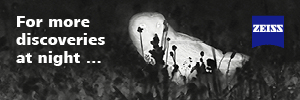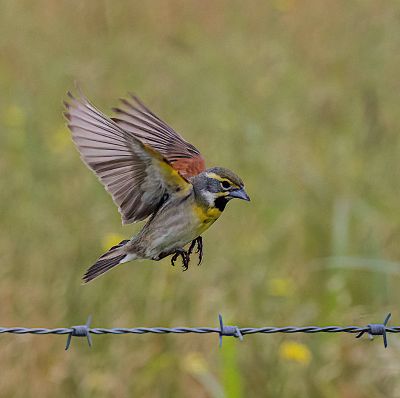Dickcissel male landing, Barnes Road, east of Salado, Bell County.jpg
- Spiza americana
Identification
6" (15 cm)
Male
- Yellow breast
- Black 'V' on throat
- Heavy bill
- Chestnut wing patch
Female
- Yellowish throat and breast
- Narrow streaks on sides
Similar Species
Male resembles meadowlark. Female much like female House Sparrow.
Distribution
Breeds from eastern Montana and Great Lakes region south to Texas and Gulf Coast, locally farther east. Migrates through Central America where some winter, but it winters mainly in northern South America.
Since the 1920s, Dickcissel has begun to reoccupy, at least in small numbers, its former breeding range in the Atlantic Coast states. Overall, though, this species has recently exhibited population declines.
Was once commonly seen on farmland in the eastern states, especially on the Atlantic coastal plain, but disappeard by the middle of the last century and is now most numerous in the Midwest. It appears in small numbers on the East Coast during the fall migration and rarely but regularly in winter at feeders, often with House Sparrows.
Taxonomy
This is a monotypic species[1], usually placed in the family Cardinalidae; some authorities have (in the past) placed it in the Icteridae (Blackbirds and Orioles).
Habitat
Open country in grain or hay fields and in weed patches.
Behaviour
Perches on stalks to pluck seeds, picks fallen seeds from ground.
Diet
They are omnivorous during the breeding season, eating insects such as grasshoppers and also vegetable matter.
Breeding
Their clutch contains 4 or 5 pale blue eggs which are laid in a cup of plant stems and grass set on or near the ground, often in alfalfa and clover fields.
Vocalisation
Song sounds like dick-dick-cissel, the first two notes being sharp sounds followed by a buzzy, almost hissed cissel; repeated over and over again from a conspicuous perch on a fence, bush, or weed.
Call: a distinctive buzzy note, often given in flight.
References
- Clements, J. F., T. S. Schulenberg, M. J. Iliff, D. Roberson, T. A. Fredericks, B. L. Sullivan, and C. L. Wood. 2018. The eBird/Clements checklist of birds of the world: v2018. Downloaded from http://www.birds.cornell.edu/clementschecklist/download/
- Handbook of the Birds of the World Alive (retrieved May 2019)
- BF Member observations
Recommended Citation
- BirdForum Opus contributors. (2024) Dickcissel. In: BirdForum, the forum for wild birds and birding. Retrieved 26 April 2024 from https://www.birdforum.net/opus/Dickcissel
External Links
GSearch checked for 2020 platform.1







